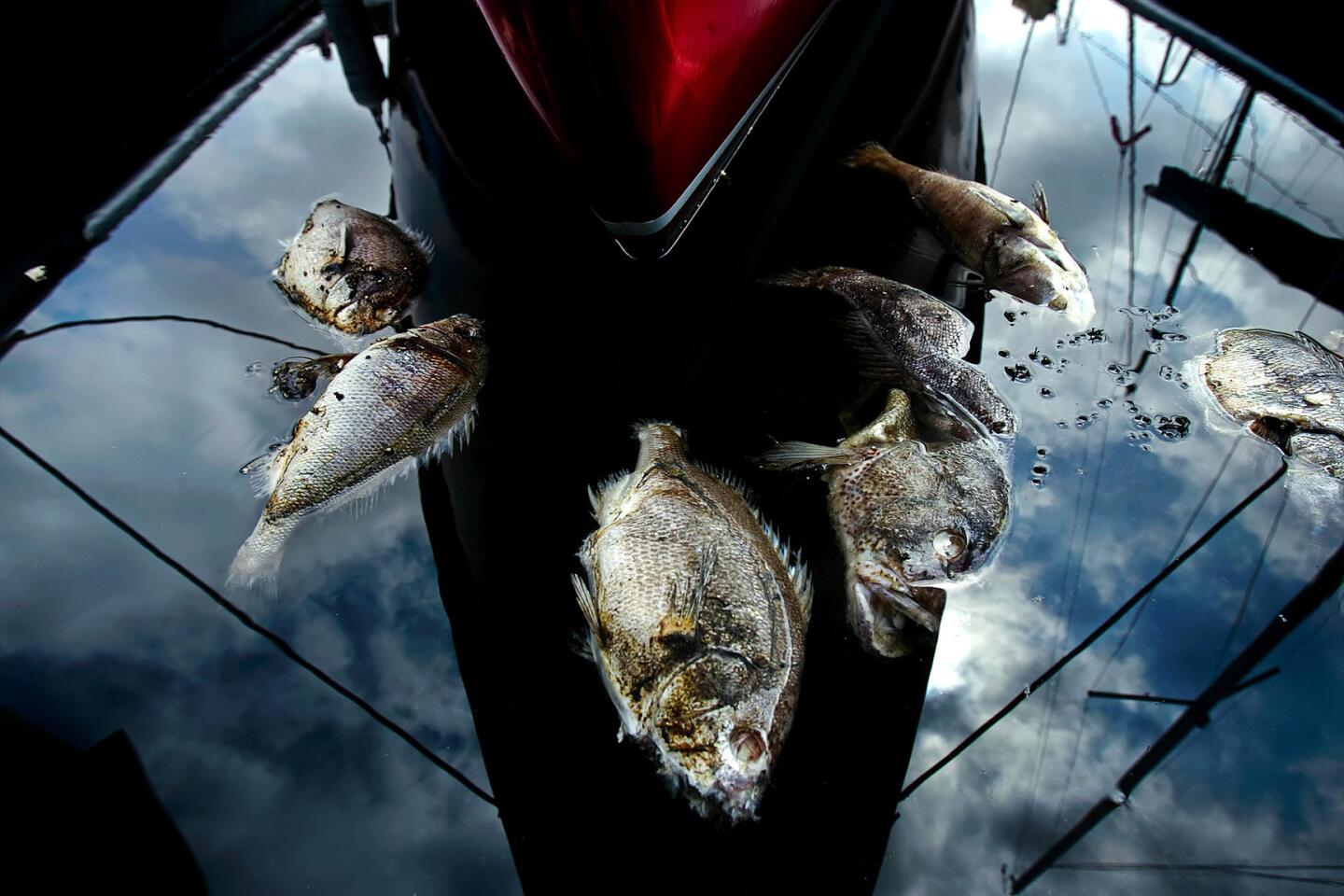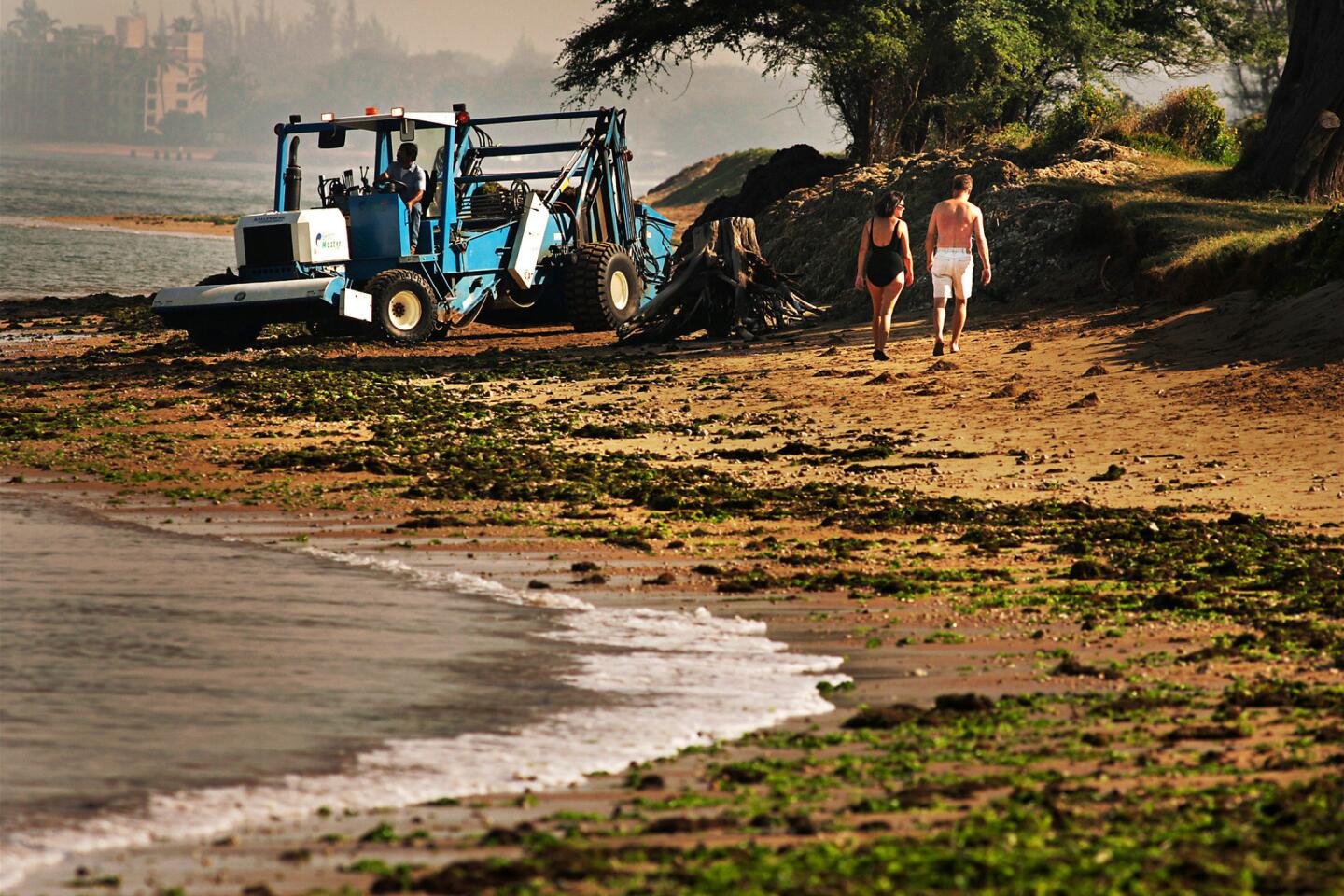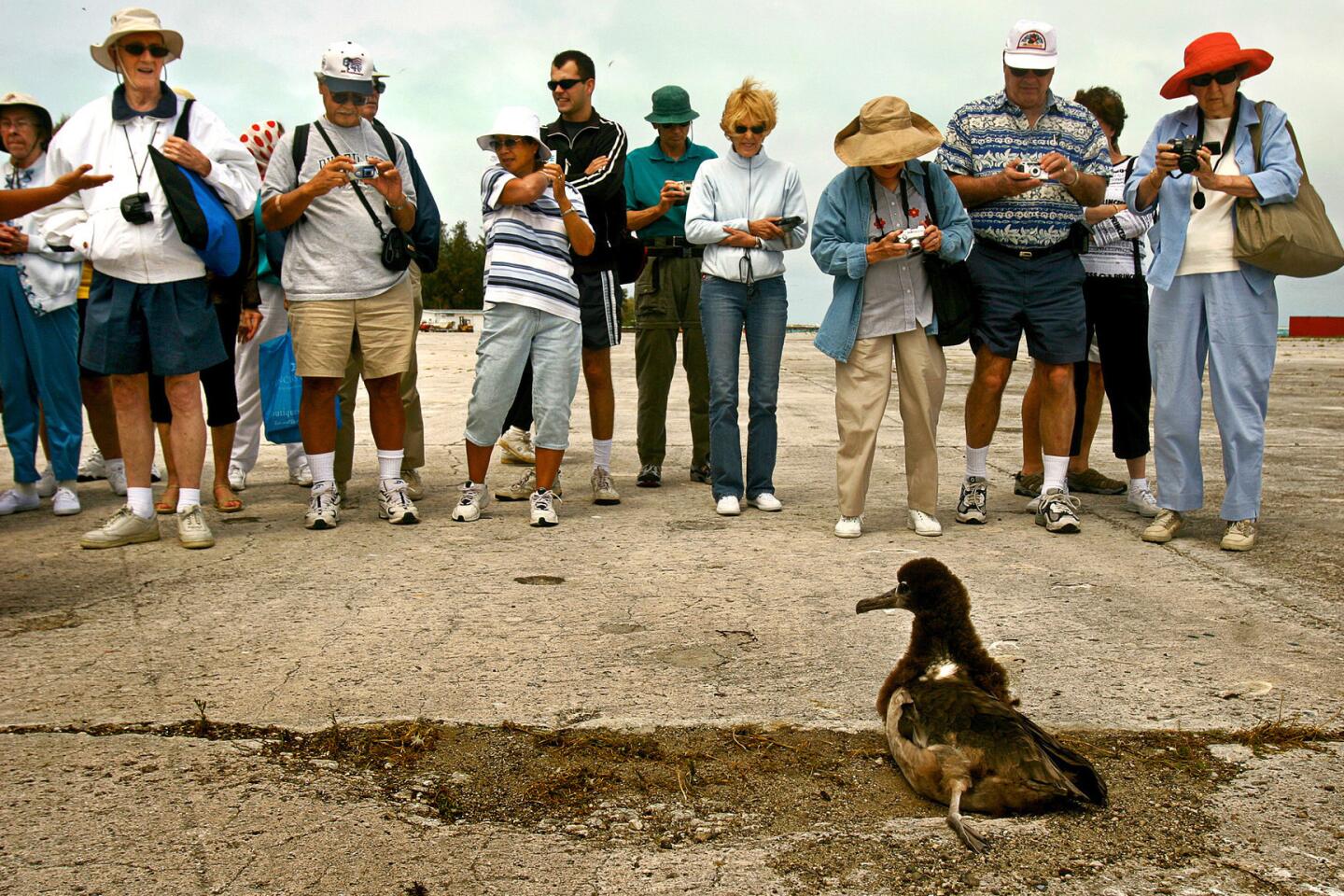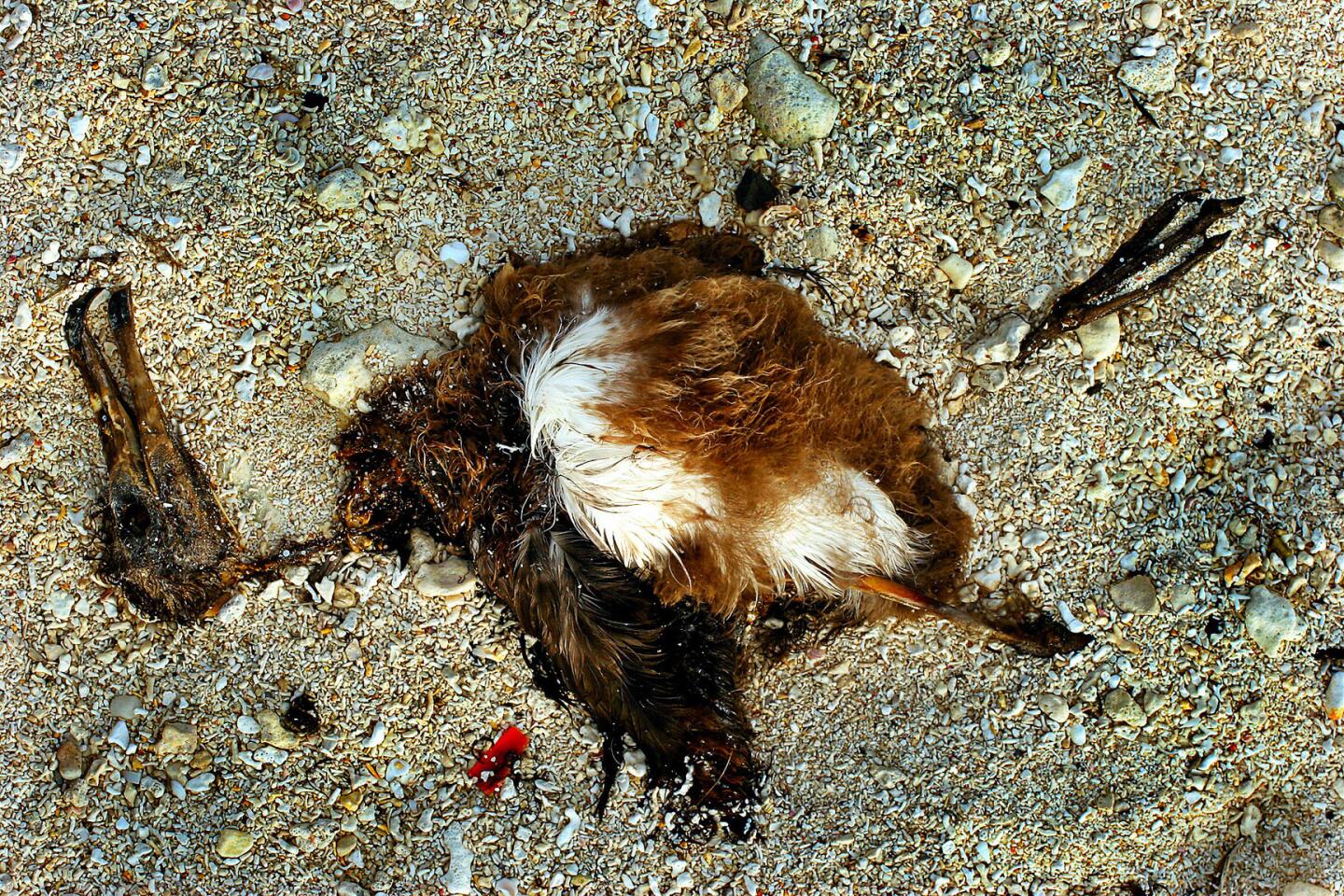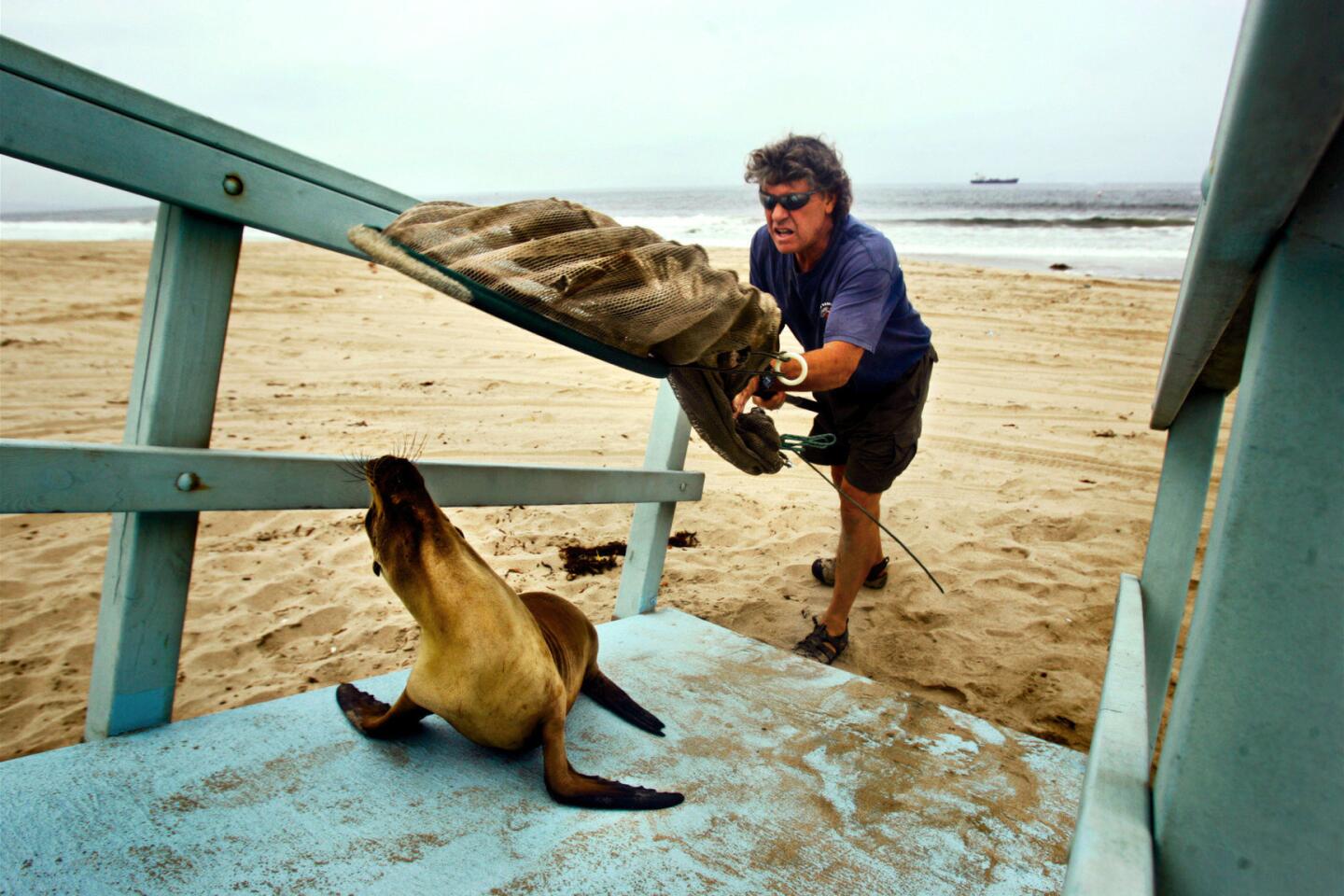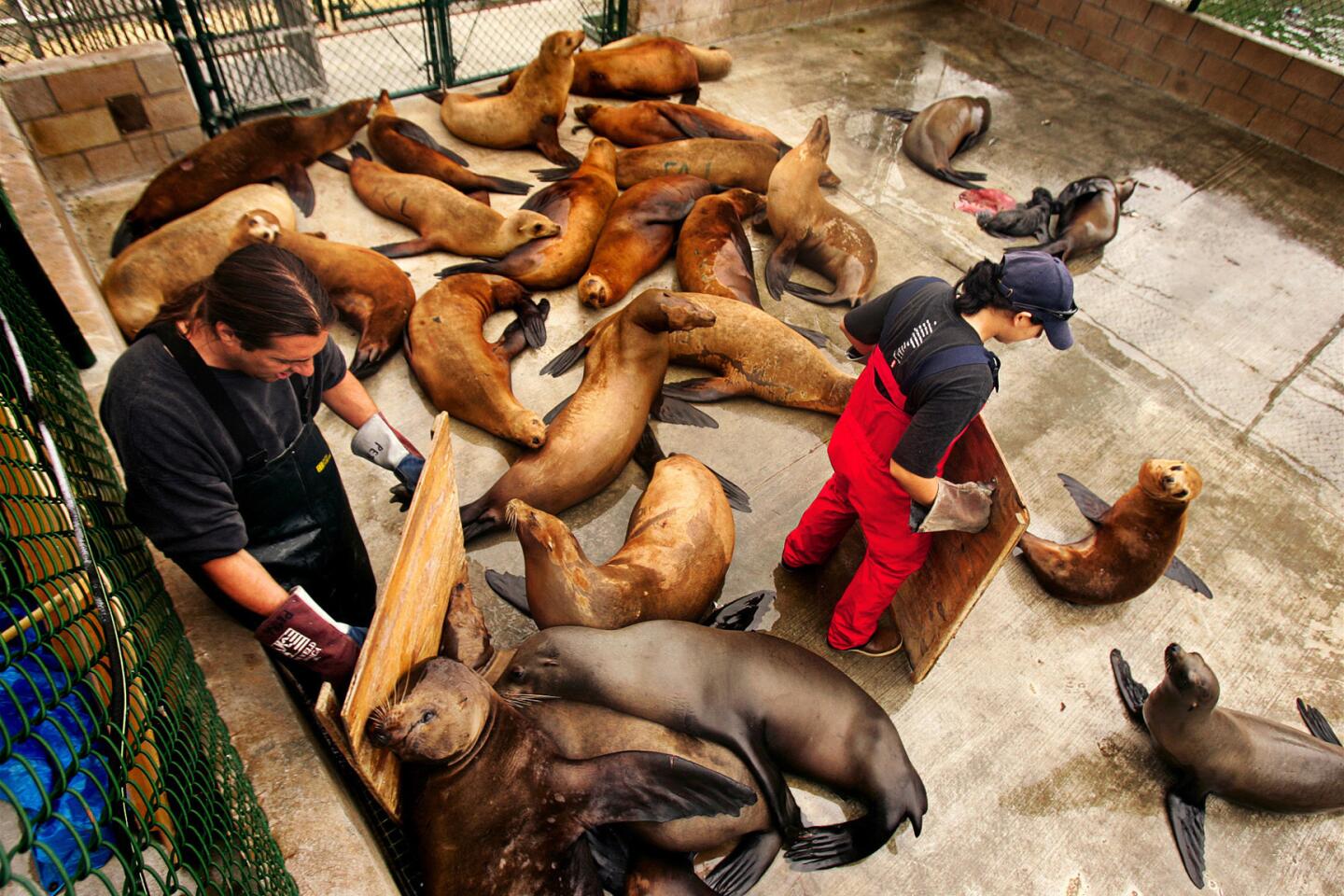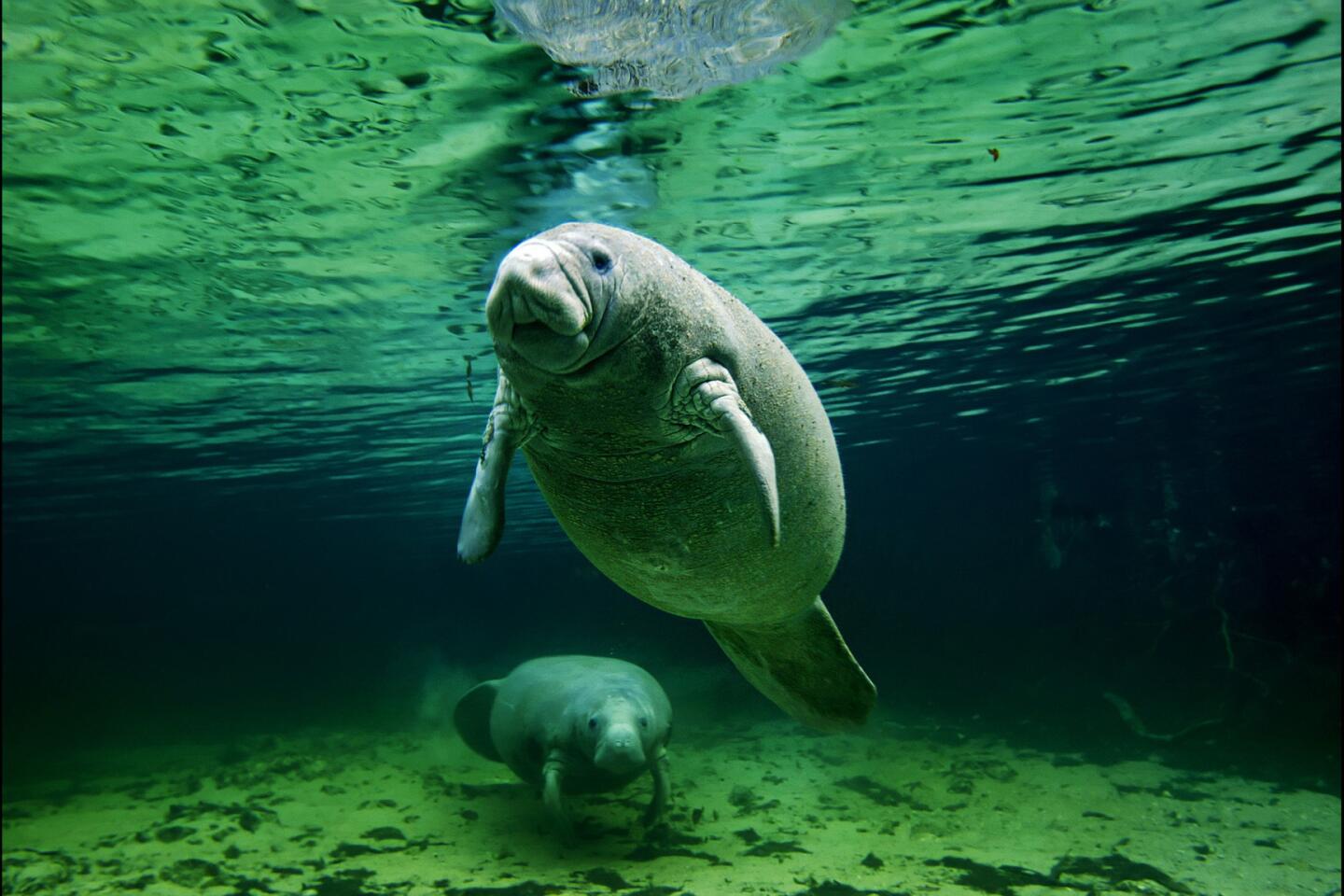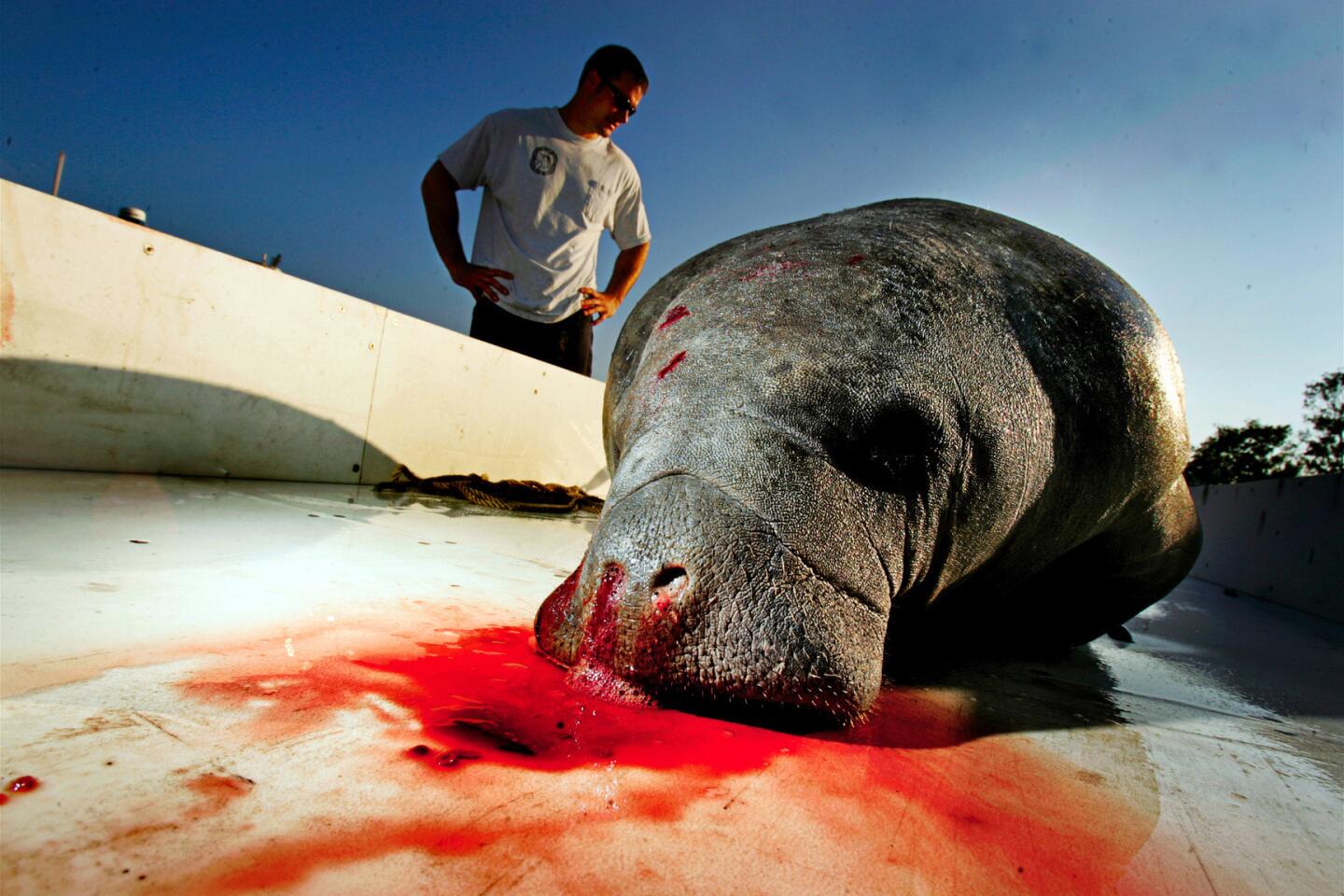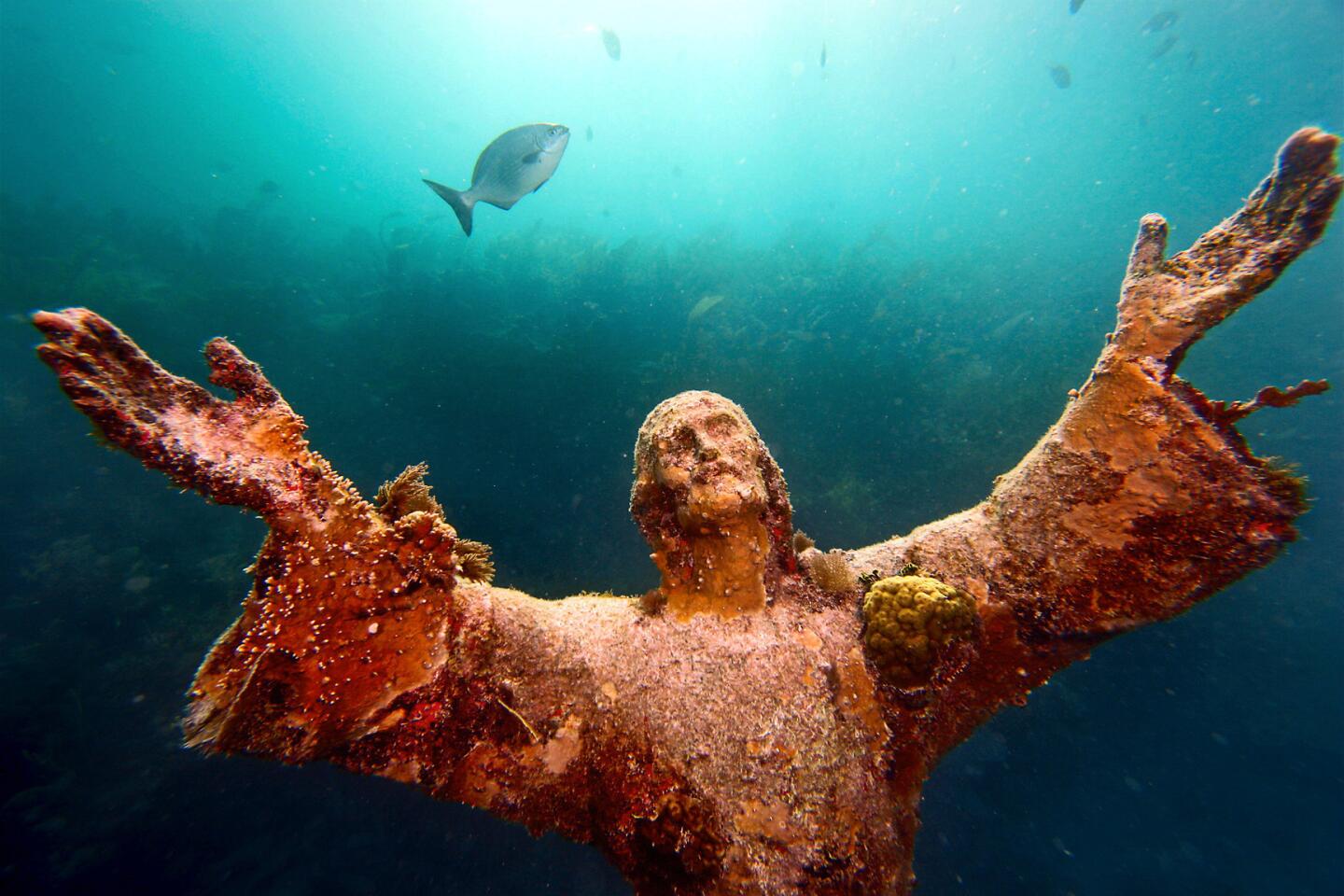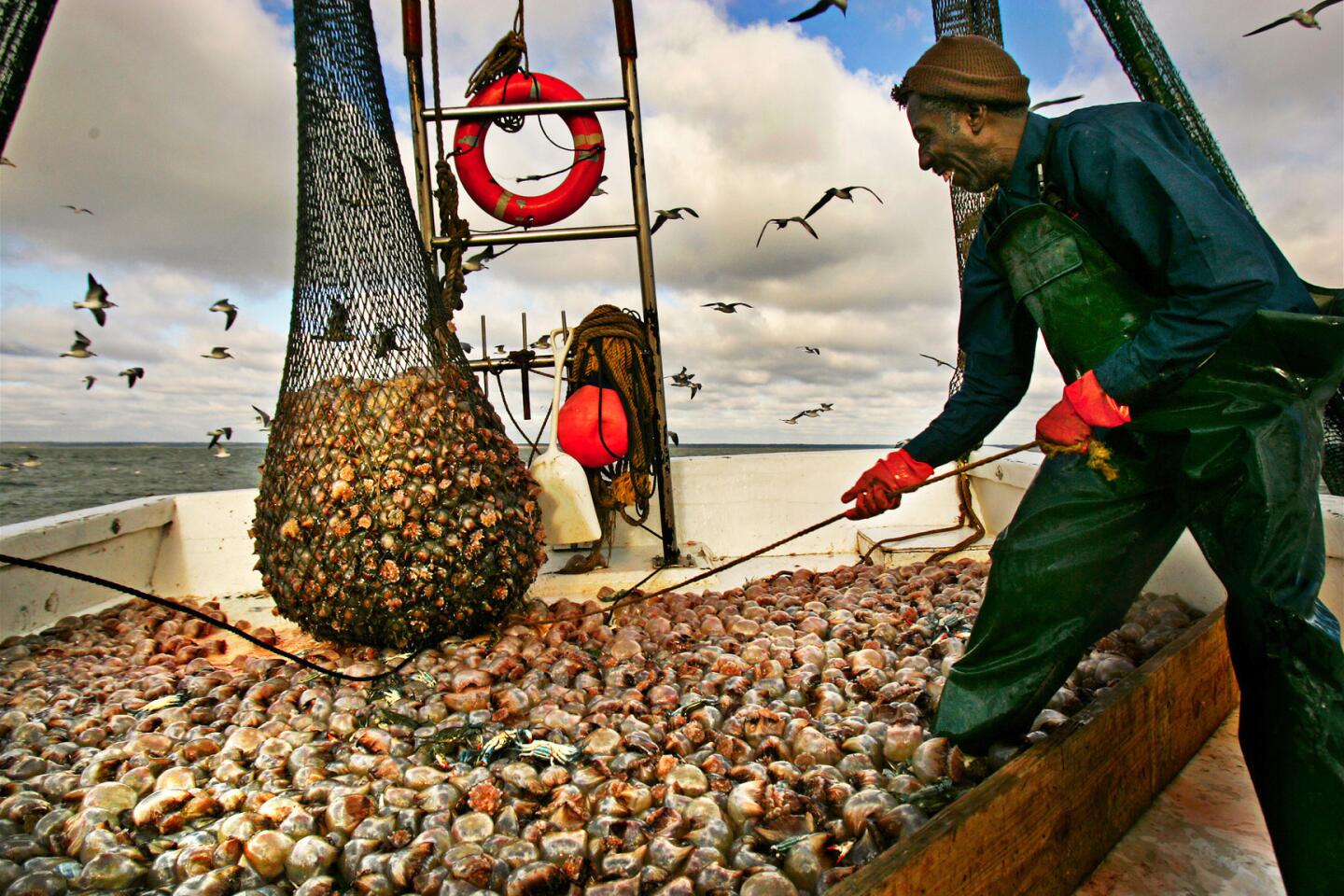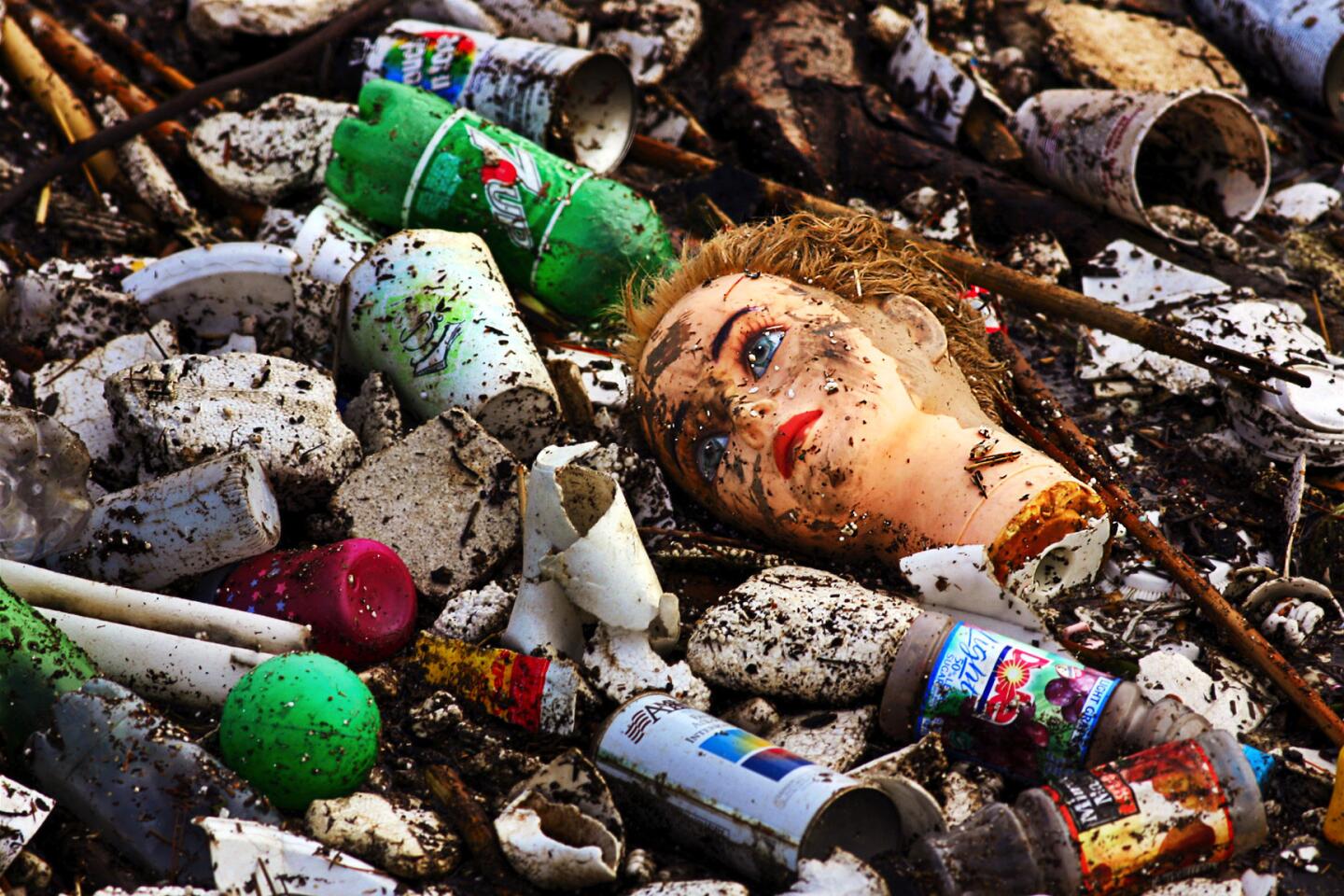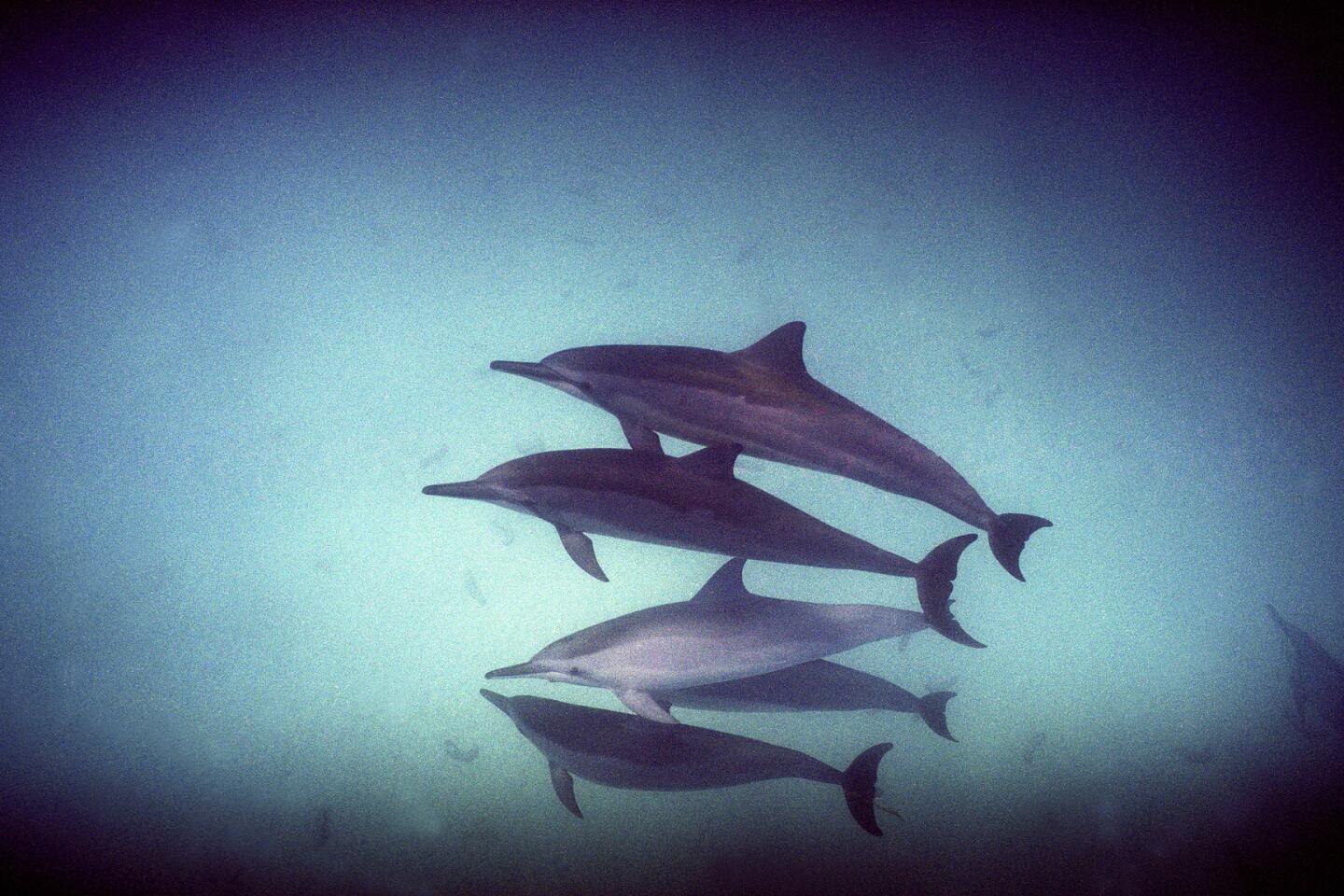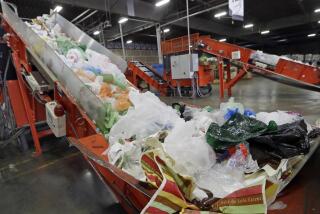Altered Oceans: Part Four: Plague of Plastic Chokes the Seas
- Share via
Reporting From MIDWAY ATOLL — The albatross chick jumped to its feet, eyes alert and focused. At 5 months, it stood 18 inches tall and was fully feathered except for the fuzz that fringed its head.
All attitude, the chick straightened up and clacked its beak at a visitor, then rocked back and dangled webbed feet in the air to cool them in the afternoon breeze.
The next afternoon, the chick ignored passersby. The bird was flopped on its belly, its legs splayed awkwardly. Its wings drooped in the hot sun. A few hours later, the chick was dead.
John Klavitter, a wildlife biologist, turned the bird over and cut it open with a knife. Probing its innards with a gloved hand, he pulled out a yellowish sac — its stomach.
Out tumbled a collection of red, blue and orange bottle caps, a black spray nozzle, part of a green comb, a white golf tee and a clump of tiny dark squid beaks ensnared in a tangle of fishing line.
“This is pretty typical,” said Klavitter, who is stationed at the atoll for the U.S. Fish and Wildlife Service. “We often find cigarette lighters, bucket handles, toothbrushes, syringes, toy soldiers — anything made out of plastic.”
It’s all part of a tide of plastic debris that has spread throughout the world’s oceans, posing a lethal hazard to wildlife, even here, more than 1,000 miles from the nearest city.
Midway, an atoll halfway between North America and Japan, has no industrial centers, no fast-food joints with overflowing trash cans, and only a few dozen people.
Its isolation would seem to make it an ideal rookery for seabirds, especially Laysan albatross, which lay their eggs and hatch their young here each winter. For their first six months of life, the chicks depend entirely on their parents for nourishment. The adults forage at sea and bring back high-calorie takeout: a slurry of partly digested squid and flying-fish eggs.
As they scour the ocean surface for this sustenance, albatross encounter vast expanses of floating junk. They pick up all manner of plastic debris, mistaking it for food.
As a result, the regurgitated payload flowing down their chicks’ gullets now includes Lego blocks, clothespins, fishing lures and other pieces of plastic that can perforate the stomach or block the gizzard or esophagus. The sheer volume of plastic inside a chick can leave little room for food and liquid.
Of the 500,000 albatross chicks born here each year, about 200,000 die, mostly from dehydration or starvation. A two-year study funded by the U.S. Environmental Protection Agency showed that chicks that died from those causes had twice as much plastic in their stomachs as those that died for other reasons.
The atoll is littered with decomposing remains, grisly wreaths of feathers and bone surrounding colorful piles of bottle caps, plastic dinosaurs, checkers, highlighter pens, perfume bottles, fishing line and small Styrofoam balls. Klavitter has calculated that albatross feed their chicks about 5 tons of plastic a year at Midway.
Albatross fly hundreds of miles in their search for food for their young. Their flight paths from Midway often take them over what is perhaps the world’s largest dump: a slowly rotating mass of trash-laden water about twice the size of Texas.
This is known as the Eastern Garbage Patch, part of a system of currents called the North Pacific subtropical gyre. Located halfway between San Francisco and Hawaii, the garbage patch is an area of slack winds and sluggish currents where flotsam collects from around the Pacific, much like foam piling up in the calm center of a hot tub.
Curtis Ebbesmeyer has been studying the clockwise swirl of plastic debris so long, he talks about it as if he were tracking a beast.
“It moves around like a big animal without a leash,” said Ebbesmeyer, an oceanographer in Seattle and leading expert on currents and marine debris. “When it gets close to an island, the garbage patch barfs, and you get a beach covered with this confetti of plastic.”
Some oceanic trash washes ashore at Midway — laundry baskets, television tubes, beach sandals, soccer balls and other discards.
Nearly 90% of floating marine litter is plastic — supple, durable materials such as polyethylene and polypropylene, Styrofoam, nylon and saran.
About four-fifths of marine trash comes from land, swept by wind or washed by rain off highways and city streets, down streams and rivers, and out to sea.
The rest comes from ships. Much of it consists of synthetic floats and other gear that is jettisoned illegally to avoid the cost of proper disposal in port.
In addition, thousands of cargo containers fall overboard in stormy seas each year, spilling their contents. One ship heading from Los Angeles to Tacoma, Wash., disgorged 33,000 blue-and-white Nike basketball shoes in 2002. Other loads lost at sea include 34,000 hockey gloves and 29,000 yellow rubber ducks and other bathtub toys.
The debris can spin for decades in one of a dozen or more gigantic gyres around the globe, only to be spat out and carried by currents to distant lands. The U.N. Environment Program estimates that 46,000 pieces of plastic litter are floating on every square mile of the oceans. About 70% will eventually sink.
Albatross are by no means the only victims. An estimated 1 million seabirds choke or get tangled in plastic nets or other debris every year. About 100,000 seals, sea lions, whales, dolphins, other marine mammals and sea turtles suffer the same fate.
The amount of plastic in the oceans has risen sharply since the 1950s. Studies show a tenfold increase every decade in some places. Scientists expect the trend to continue, given the popularity of disposable plastic containers. The average American used 223 pounds of plastic in 2001. The plastics industry expects per-capita usage to increase to 326 pounds by the end of the decade.
The qualities that make plastics so useful are precisely what cause them to persist as trash.
Derived from petroleum, plastics eventually break down into carbon dioxide and water from exposure to heat and the sun’s ultraviolet rays.
On land, the process can take decades, even centuries. At sea, it takes even longer, said Anthony L. Andrady, a polymer chemist at the Research Triangle Institute in North Carolina who studies marine debris. Seawater keeps plastics cool while algae, barnacles and other marine growth block ultraviolet rays.
“Every little piece of plastic manufactured in the past 50 years that made it into the ocean is still out there somewhere,” Andrady said, “because there is no effective mechanism to break it down.”
Oceanographers have counted on beachcombers around the world to help them plot the course of plastic flotsam as it circumnavigates the globe. Ebbesmeyer has found that some debris gets hung up for decades in gyres before being spun out into different currents, flung ashore or picked up by animals.
A piece of plastic found in an albatross stomach last year bore a serial number that was traced to a World War II seaplane shot down in 1944. Computer models re-creating the object’s odyssey showed it spent a decade in a gyre known as the Western Garbage Patch, just south of Japan, and then drifted 6,000 miles to the Eastern Garbage Patch off the West Coast of the U.S., where it spun in circles for the next 50 years.
The Hawaiian archipelago, which stretches from the Big Island of Hawaii westward for 1,500 miles to Kure Atoll, acts like 19 unevenly spaced teeth of a giant comb, snagging debris drifting around the Pacific. Most of the archipelago’s atolls are awash in plastic junk, as are some beaches on the main islands.
Native Hawaiians, seeking wood for dugout canoes, used to go to Kamilo Beach at the southernmost tip of the Big Island to collect enormous logs that had drifted from the Pacific Northwest. Now, locals like Noni Sanford pick through the debris for novelties to enter in a trash-art show in Hilo every fall.
Sanford, 58, a free-spirited great-grandmother with long gray hair pulled back in a ponytail, once won second place for a mobile fashioned out of fishing line, floats and a colorful palette of plastic toothbrushes.
As a lifelong beachcomber, she is fascinated and horrified by the transformation of Kamilo Beach since she first set foot there in 1959. She was searching for driftwood with her father, a sculptor.
She remembers seeing a few tires back then. Now, plastic debris litters the crescent-shaped beach for more than a mile.
“This is nothing,” Sanford said, stepping over a pile of twisted lines and nets. “This used to be 8 and 10 feet high. Of course, that was three or four cleanups ago.”
Sanford and her husband, Ron, have joined in regular cleanup efforts, organized most recently by Bill Gilmartin, a retired wildlife biologist who studied monk seals.
“The rule is, don’t pick up anything smaller than your fist,” Gilmartin told a team of volunteers. “Otherwise, it’ll take forever. We’ll never be done.”
Noni Sanford reached down, scooped up a handful of beach sand and let it trickle through her fingers. Most of the grainy mix was bits and pieces of plastic. The beach itself, it seemed, was turning into plastic.
Cleanup efforts in Hawaii and elsewhere have focused on “ghost nets,” tangles of abandoned fishing lines, nets and traps that snare and kill marine life.
The National Oceanic and Atmospheric Administration dispatches scuba divers every year to cut tons of these deathtraps off Hawaiian coral reefs. It’s dangerous and costly work. In July 2005, a 145-foot charter vessel brought in to haul away nets ran aground on the reef at Pearl and Hermes Atoll, about 100 miles from Midway. The ship was lost. The Coast Guard flew the 23 divers and crew 1,200 miles back to Honolulu.
If it were easier to find them, it would make sense to round up the medusas of nets and synthetic lines at sea before they snagged on coral reefs and endangered monk seals and other coastal wildlife.
But the Pacific spans millions of square miles, and even the debris circulating in the Eastern and Western garbage patches is often diffuse and hard to see, bobbing just below the surface.
Connecting the two patches is a ribbon of oceanic highway that stretches 6,000 miles, an extension of Japan’s Kuroshio Current heading east. Oceanographers call this the Subtropical Convergence Zone, where the cold, green, heavier waters from the north slide under the warm, blue waters of the south.
A team of scientists working on NOAA’s GhostNet Detection Project suspected that flotsam collected along this line, making it an ideal place to concentrate cleanups. Yet they couldn’t be sure. They needed to see it.
The team got its chance last year, after persuading NOAA to lend them an instrument-packed, four-engine reconnaissance plane often deployed to study hurricanes. Wearing life jackets while flying 1,000 feet above the ocean’s surface, observers were positioned at windows to spot nets and floats. They were to call out each sighting over the plane’s intercom. Others were poised to jot down the location of each sighting.
“When we got into it, we couldn’t write fast enough,” said Tim Veenstra, an Alaskan pilot and private researcher working with government scientists. The meandering line of buoys, nets, life rings, buckets and other castoffs stretched for hundreds and hundreds of miles — until the airplane had to turn back.
“It was sort of a bittersweet feeling,” Veenstra said. “Sweet in the fact that what we had postulated was proven true. Bitter in the fact that there was actually that much debris floating around.”
Tuna fishermen have long known about the convergence zone and the debris. They know that fish like to congregate beneath anything that floats.
Off the southern tip of the Big Island of Hawaii, recreational fishermen like Guy Enriques will race miles offshore to fish beneath the flotsam.
It’s important to get close to the trash, but not too close, Enriques explained, or the nets and lines will wrap around a boat’s propeller.
He said the best fishing was around what looked like an enormous metal garage door floating just below the water’s surface. Even some charter boat skippers learned of that one, Enriques recalled, and took fishermen there day after day, until it vanished.
But it wasn’t a garage door. He and other fishermen were looking at the top of an 8-by-40-foot cargo container that fell off a ship. Such containers can float for as long as nine months. Until they sink, they are the bane of sailors in fiberglass boats who watch for them like icebergs on the high seas.
Charles Moore, a member of the Hancock Oil family, was on his way home from the Los Angeles-to-Hawaii Transpacific Yacht Race in 1997 when he took a shortcut through the Eastern Garbage Patch. It’s a place that sailors usually avoid because it lacks wind.
As he motored through on his 50-foot catamaran, Moore was startled by what he saw thousands of miles from land. “Every time I came on deck, there was trash floating by,” he said. “How could we have fouled such a huge area? How could this go on for a week?”
The experience changed Moore’s life, turning him from an adventurer into a self-taught scientist and environmental activist.
Two years later, he returned to the garbage patch with a volunteer crew to survey its contents. He knew he would collect plenty of plastic bags, bottle caps, nets and floats.
He didn’t expect what turned up in a special net, one with a tight mesh for collecting plankton, the bottom link in the oceanic food chain. Instead of plankton, it was choked with a colorful array of tiny plastic fragments.
“It blew my mind,” Moore said. “We are filling up the oceans with this confetti stuff, and nobody cares.”
Over the last decade, Moore, 59, who lives in a waterfront home in Long Beach, has spent his own money and some from a family foundation on a quest to track the plume of plastic so he can figure out how to stop it.
On a cloudless spring day, Moore waded up to his knees into the Los Angeles River in Long Beach wearing shorts, sandals and a white hard hat. He was tethered to a volunteer standing on the dry riverbank, in case he slipped on the slick concrete channel.
The Los Angeles River carries enough trash each year to fill the Rose Bowl two stories high, and despite efforts to corral some of it near the river mouth, most slips through to the ocean.
Moore adjusted a trawlnet to collect trash flowing downriver. At Moore’s signal, a crane operator lifted the net out of the water. Volunteers swarmed around the trawlnet, extracted the contents and loaded them into more than a dozen jars.
The jars were filled with plastic pellets the size and shape of pills. They come in all colors and are the raw material for a vast array of plastic products, from trash bags to medical devices.
About 100 billion pounds of pellets are produced every year and shipped to Los Angeles and other manufacturing centers. Huge numbers are spilled on the ground and swept by rainfall into gutters; down storm drains, creeks and rivers; and into the ocean.
From his river sampling, Moore estimated that 236 million pellets washed down the Los Angeles and San Gabriel rivers in three days’ time. Also known as “nurdles” or mermaid tears, they are the most widely seen plastic debris around the world. They have washed ashore as far away as Antarctica.
The pellets, like most types of plastic, are sponges for oily toxic chemicals that don’t readily dissolve in water, such as the pesticide DDT and polychlorinated biphenyls, or PCBs. Some pellets have been found to contain concentrations of these pollutants 1 million times greater than the levels found in surrounding water.
As they absorb toxic chemicals, they become poison pills. Wildlife researchers have found the pellets, which resemble fish eggs, in the bellies of fish, sea turtles, seabirds and marine mammals.
Over time, plastic can break down into smaller and smaller pieces, eventually turning to powder and entering the ocean in microscopic fragments. Some plastic starts out as tiny particles, such as the abrasives in cleaning products that are washed down the sink, through sewage systems and out to sea.
The chemical components of plastics and common additives can harm animals and humans. Studies have linked the hormone-mimicking phthalates, used to soften plastic, to reduced testosterone and fertility in laboratory animals, and to subtle changes in the genitals of baby boys. Another additive, bisphenol A, used to make lightweight, heat-resistant baby bottles and microwave cookware, has been linked to prostate cancer.
Moore has tried, without success, to get manufacturers to improve their efforts to clean up spills of pellets that wash off lots and into storm drains. He considers beach cleanups a waste of time, except to raise public awareness of the problem. In his view, the cleanup has to start at the source — many miles inland.
To make that point, Moore tromped through rail yards in Vernon and La Mirada. On the side of a rail car a faded decal read “Operation Clean Sweep.” It had three check boxes:
“Keep Plastics Off Ground.
“Close and Lock Caps When Outlets Not in Use.
“Pick Up All Spills.”
Beneath the sign was a cone-shaped pile of pellets, as white as freshly fallen snow. Moore shuffled his sandaled feet through another drift nearby.
“This is a plastic sand dune,” he said. “It’s very slippery, very roly-poly. What makes them so good for the factory makes them good for getting into the ocean.”
Times staff writer Usha Lee McFarling contributed to this report.
Next: Altered Oceans, Part Five: A Chemical Imbalance
Full coverage: Altered Oceans
More to Read
Sign up for Essential California
The most important California stories and recommendations in your inbox every morning.
You may occasionally receive promotional content from the Los Angeles Times.
